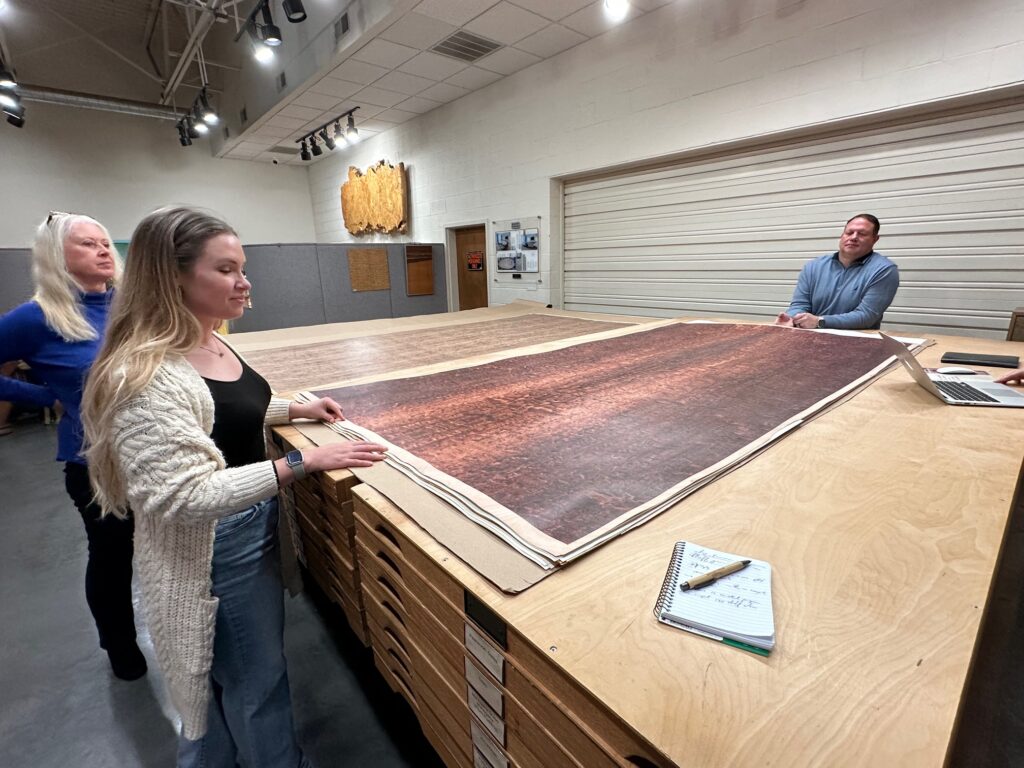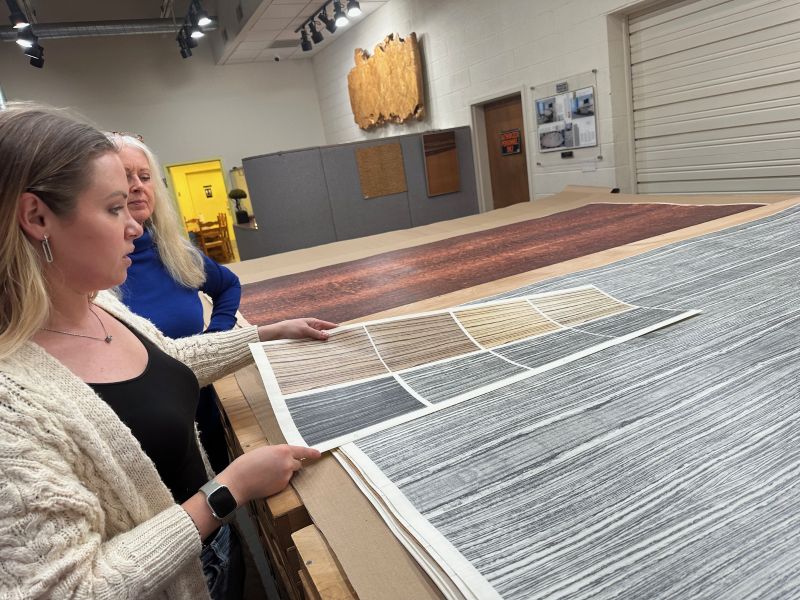High Point-based veneer supplier has improved its LithoWood process, which reproduces images of hard-to-find, exotic wood species onto mostly maple substrates
HIGH POINT — In a world where certain wood species are becoming more rare, restricted and thus prohibitively expensive, case goods resources, not to mention designers and architects, can find themselves in a tough spot.
The question is thus whether they choose to use exotic species, or some other alternative that’s more readily available for various collections or projects.
Herzog Veneers, whose success over the past four decades has largely been through the sale of such exotic veneers to the furniture industry, has developed a solution that provides the same looks these species offer at a hugely competitive price.
The solution is called LithoWood, a product that involves the printing of exotic species onto maple substrates that then are sold in sheets for various projects, ranging from case goods collections to the panels of executive offices. The images are developed in-house from an extensive library of exotic veneers the company has acquired over the years, ranging from bird’s-eye maple and ebony macassar to Daniella and crotch mahogany, to name several.
From there, the images are printed on the maple substrates and sold to furniture companies, designers and others seeking a high-end look at a fraction of the cost. For example, a starting price for a 4X8-foot sheet of macassar ebony would be around $1,200, while a similar sized sheet of LithoWood would be around $250.

As it is a challenge to find such large sheets of these types of exotic veneers, the price can get even higher. And then “to get it consistent is next to impossible,” said Chantal Parisette-Haynes, co-owner of Herzog Veneers.
The company has been using the technology since before the pandemic starting around early 2020. Since then, it has changed the way it has done the imaging and the printing to create a sharper image that showcases the wood grains in even more detail.
“We kept running into all these roadblocks where the printing was good, but it was a little fuzzy,” Parisette-Haynes continued. “The grain definition was not quite there — it was a little flat and not what we wanted to see. Now the technology has caught up with what we were attempting to do.”
And with the use of a maple substrate, she emphasized that “this is still a real piece of wood. It is just digitally enhanced.”
The technology is indeed a shift for Herzog Veneers, which became well known in the industry since its founding in 1982 by the Herzog family. Today it is a fifth-generation business that involves Chantal and her parents Sabrina and Sam Parisette-Herzog. Chantal’s husband, Chris Haynes, also helps out with the business.
The expense of harder-to-source species is not the only challenge. Often, certain species that are harvested are smaller, which limits the size of the pattern and also limits consistency in the pattern that can be applied to the surface of a headboard or dresser drawer fronts, for example.
So co-owner Sabrina Parisette-Herzog kept samples of the original patterns from many exotic wood species, and the company captured images of them to develop and maintain a library of various sized images highlighting their dramatic wood grains. This allows its current clients to pick from a broad range of images to use in any type of wood product, whether it’s paneling for the interior of a private jet or a new case goods collection.
By picking the specific panels they want, a company can offer anything from a book-matched crotch mahogany or a radial pattern for a round tabletop, for example.

The technology also allows the company to create different hues that suit the needs of the clients, ranging from lighter to darker tones.
Clients can select these and other patterns or styles using a tool on the company website. The tones are then applied to the images and printed on mostly maple veneer substrates.
Officials noted that the printing technology has improved, to create not only a better image, but a surface that is more durable thanks to the clear-coat finish and the quality of the actual inks used.
“The printers have improved in quality dramatically,” Chantal Parisette Haynes said, adding, “These are UV stable inks and we have done 100-hour tests on them. The ink does not move at all, which is a big concern with natural wood products. … So it, by default, protects the wood underneath.”
“Right now we have images that are so high resolution that the printers are only printing about a third of what’s in the image,” she added, noting that the process captures the beauty of the wood grains so that the product looks as real as any particular wood species. “As the printers have become better and better, these images are still going to be relevant probably over the next 20 years.”
LithoWood is available through a stock program of some 10 specific wood patterns that can ship within a day from the order. Altogether, the company has developed images from 135 different species, that with specific colorations can be shipped in three to four weeks.
“We have a specific studio that works with us, and we can change the color on that to whatever you want,” Sam Parisette-Herzog said, describing it as a multistep process that’s similar in ways to multistep finishing. “We get the images correct and then we can adjust the color there. That is why we spend so much time getting the color right, so at the end of the day they can just put a clear coat on it. Nothing changes. All they have to do is lay it up and use whatever (clear) finish they are using in the shop. So no one has to change the process to use the product.”
The coloration process is particularly helpful for manufacturers or importers that want to put their custom mark on a piece.
“Every time we have worked with a furniture company, they have been like, ‘This is good, but I have a very specific color we are trying to match to something that is already in the line.’” Chantal said. “Or they have brought us a swatch of fabric from a sofa and they say this is the sofa that goes with the line and I want X amount of color.”
In this respect, she added, it can be less about the original wood species and more about what the final aesthetic is going to be. “And they can customize it to what they want.”
Currently, LithoWood represents about 20% of sales, which the company sees growing to about 50% over time. As much as 90% of the current business in LithoWood is in the furniture industry.
Thus, hospitality and other commercial applications represent a big growth opportunity.
A big part of the appeal that LithoWood has in the hospitality industry is that it allows wood pieces to look consistent from room to room. In one case, a client wanted to have the same look on furniture in every room, which the company said required the use of LithoWood because it just can’t be done naturally given the different grain patterns of each individual tree or individual log.
The consistency also comes into play when a client needs a replacement for a piece of furniture where the finish has been worn or damaged. By using LithoWood, they can get a replacement sheet bearing the same grain pattern.
“If someone damages a drawer, we can just redo them and it waterfalls down perfectly,” Chantal said. “So you don’t have to rip out the whole unit. So for replacement pieces, this is phenomenal.”
“Even with the consumer, if something happens, we can get you this (replacement) piece and it is going to fit into what you have,” she added. “And it is still going to look like a piece of custom wood veneer furniture.”
The company is also revamping its website in a way that helps the designer understand how a specific veneer pattern can be applied to a specific piece of furniture, with images of various completed pieces using specific varieties of LithoWood. The site also continues to use various custom tools to create certain patterns.
The company also will feature more items in inventory and more prominently highlight its PanelWizard tool that allows clients to build real-time images of virtually matched panels directly from stock.
The company still offers its regular veneers that customers can buy in various size sheets and patterns. This includes things like European sycamore, rift cut oak, maple and walnut veneers, for example.
But over time, it expects the LithoWood selection to become more popular representing as much as 50% of its sales volume compared with as much as 30% in a year previously.
Again the realities of the market are dictating this shift, notes Sabrina Parisette-Herzog.
“I just can’t find the logs that are this dimension or this length or width and are perfect in terms of color and grain,” Sabrina said. “We just can’t find them anymore and they are prohibitively expensive. But even with protected species that we can’t get any more we can print those, too.”
But will the consumer notice? Based on the success the company has seen with the effort so far, officials believe LithoWood has a bright future indeed.
“There is less and less focus on the consumer truly knowing what those individual woods are versus looking at something and saying, ‘That’s beautiful and what I want. And it’s going to go perfectly in my house and it’s going to match.'” Chantal noted. “So we have really focused on the aesthetics.”




